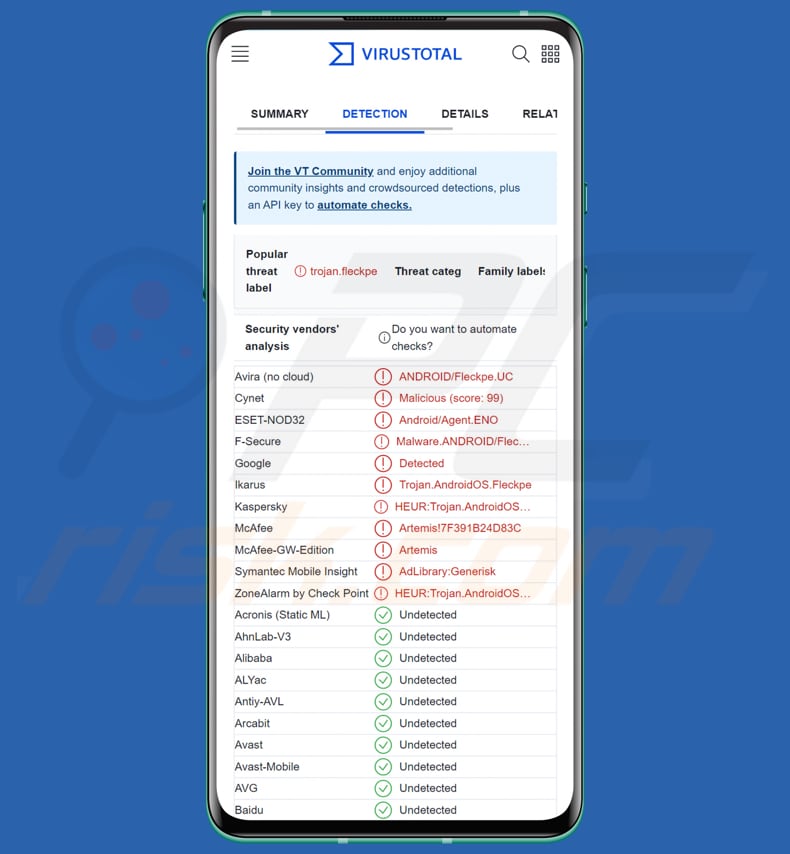Get free scan and check if your device is infected.
Remove it nowTo use full-featured product, you have to purchase a license for Combo Cleaner. Seven days free trial available. Combo Cleaner is owned and operated by RCS LT, the parent company of PCRisk.com.
What kind of malware is Fleckpe?
Fleckpe is a recently discovered Android Trojan family found on Google Play, which secretly subscribes victims to paid services. This Trojan primarily affects users in Thailand. It has been active since the start of 2022 and is continuously updated with new capabilities.

More about Fleckpe Android malware
Cybercriminals can benefit from Fleckpe in multiple ways. Firstly, by subscribing users to paid services without their knowledge, they can generate revenue for themselves. Secondly, they can use the personal information obtained from the infected device for further malicious activities such as identity theft, phishing, or targeted attacks.
Also, by compromising the devices, the attackers can potentially gain control over the device and use it for their botnet network, a collection of infected devices that can be used for distributed denial-of-service (DDoS) attacks, crypto-mining, or other illegal activities.
Victims of Fleckpe may experience unexpected charges due to the subscription services that the Trojan signs them up for without their knowledge. Additionally, the Trojan may also have access to personal information on devices, which could potentially be used for malicious purposes such as identity theft or financial fraud.
Furthermore, if the Trojan is not detected and removed, it may continue to sign victims up for additional services and cause further financial harm.
| Name | Fleckpe malware |
| Threat Type | Android malware, malicious application, unwanted application. |
| Detection Names | Avira (ANDROID/Fleckpe.UC), Cynet (Malicious (score: 99)), ESET-NOD32 (Android/Agent.ENO), Kaspersky (HEUR:Trojan.AndroidOS.Fleckpe.a), Full List (VirusTotal) |
| Symptoms | Charges for paid subscriptions |
| Distribution methods | Infected applications on Google Play and possibly other methods (e.g., malicious online advertisements, social engineering, deceptive applications, or scam websites) |
| Damage |
Stolen personal information, decreased device performance, battery is drained quickly, decreased Internet speed, huge data losses, monetary losses, stolen identity |
| Malware Removal (Windows) |
To eliminate possible malware infections, scan your computer with legitimate antivirus software. Our security researchers recommend using Combo Cleaner. Download Combo CleanerTo use full-featured product, you have to purchase a license for Combo Cleaner. 7 days free trial available. Combo Cleaner is owned and operated by RCS LT, the parent company of PCRisk.com. |
Android malware in general
Android malware is a serious threat to mobile devices, as it can be used to perform a wide range of malicious activities. For instance, some types of Android malware are designed to steal sensitive information, such as login credentials, banking details, and personal data.
Other types of Android malware are designed to display unwanted ads or track user activity to generate revenue for the attackers. In the worst cases, Android malware can take control of the device, rendering it unusable, or even use it as a tool for other malicious activities.
Examples of Android malware are DAAM Botnet, Chameleon Malware, and Goldoson Malware.
How did Fleckpe infiltrate my device?
Fleckpe is distributed via trojanized apps, such as Beauty Slimming Photo Editor and GIF Camera Editor Pro, as well as other apps on Google Play. These apps are disguised as legitimate photo editing and camera apps but actually contain the malicious Trojan that subscribes victims to paid services without their knowledge or consent.
Also, threat actors can distribute Android malware via other channels, including but not limited to third-party app stores, social media platforms, malicious websites, phishing emails, or text messages.
How to avoid installation of malware?
Download applications from reliable sources such as the Google Play Store and official pages. Be cautious when downloading them from third-party app stores or dubious websites. Always read the app reviews, check the app permissions before installing, and keep your device's operating system and antivirus software up-to-date.
Avoid clicking on dubious links or downloading attachments from unknown sources (e.g., irrelevant emails or text messages). Do not root your device, as it can increase the risk of malware infections. Keep Google Play Protect always enabled.
Examples of apps used as a disguise for Fleckpe trojan:
- Beauty Camera Plus
- Beauty Slimming Photo Editor
- Draw Graffiti
- Fingertip Graffiti
- Gif Camera Editor Pro
- HD 4k Wallpaper
- Impressionism Pro Camera
- Microclip Video Editor
- Night Mode Camera Pro
- Photo Camera Editor
- Photo Effect Editor
Examples of Trojanized apps (Beauty Slimming Photo Editor and GIF Camera Editor Pro) used to distribute Fleckpe:
{ppgallery}


{/pppgallery}
Quick menu:
- Introduction
- How to delete browsing history from the Chrome web browser?
- How to disable browser notifications in the Chrome web browser?
- How to reset the Chrome web browser?
- How to delete browsing history from the Firefox web browser?
- How to disable browser notifications in the Firefox web browser?
- How to reset the Firefox web browser?
- How to uninstall potentially unwanted and/or malicious applications?
- How to boot the Android device in "Safe Mode"?
- How to check the battery usage of various applications?
- How to check the data usage of various applications?
- How to install the latest software updates?
- How to reset the system to its default state?
- How to disable applications that have administrator privileges?
Delete browsing history from the Chrome web browser:

Tap the "Menu" button (three dots on the right-upper corner of the screen) and select "History" in the opened dropdown menu.

Tap "Clear browsing data", select "ADVANCED" tab, choose the time range and data types you want to delete and tap "Clear data".
Disable browser notifications in the Chrome web browser:

Tap the "Menu" button (three dots on the right-upper corner of the screen) and select "Settings" in the opened dropdown menu.

Scroll down until you see "Site settings" option and tap it. Scroll down until you see "Notifications" option and tap it.

Find the websites that deliver browser notifications, tap on them and click "Clear & reset". This will remove permissions granted for these websites to deliver notifications. However, once you visit the same site again, it may ask for a permission again. You can choose whether to give these permissions or not (if you choose to decline the website will go to "Blocked" section and will no longer ask you for the permission).
Reset the Chrome web browser:

Go to "Settings", scroll down until you see "Apps" and tap it.

Scroll down until you find "Chrome" application, select it and tap "Storage" option.

Tap "MANAGE STORAGE", then "CLEAR ALL DATA" and confirm the action by taping "OK". Note that resetting the browser will eliminate all data stored within. This means that all saved logins/passwords, browsing history, non-default settings and other data will be deleted. You will also have to re-login into all websites as well.
Delete browsing history from the Firefox web browser:

Tap the "Menu" button (three dots on the right-upper corner of the screen) and select "History" in the opened dropdown menu.

Scroll down until you see "Clear private data" and tap it. Select data types you want to remove and tap "CLEAR DATA".
Disable browser notifications in the Firefox web browser:

Visit the website that is delivering browser notifications, tap the icon displayed on the left of URL bar (the icon will not necessarily be a "Lock") and select "Edit Site Settings".

In the opened pop-up opt-in the "Notifications" option and tap "CLEAR".
Reset the Firefox web browser:

Go to "Settings", scroll down until you see "Apps" and tap it.

Scroll down until you find "Firefox" application, select it and tap "Storage" option.

Tap "CLEAR DATA" and confirm the action by taping "DELETE". Note that resetting the browser will eliminate all data stored within. This means that all saved logins/passwords, browsing history, non-default settings and other data will be deleted. You will also have to re-login into all websites as well.
Uninstall potentially unwanted and/or malicious applications:

Go to "Settings", scroll down until you see "Apps" and tap it.

Scroll down until you see a potentially unwanted and/or malicious application, select it and tap "Uninstall". If, for some reason, you are unable to remove the selected app (e.g., you are prompted with an error message), you should try using the "Safe Mode".
Boot the Android device in "Safe Mode":
The "Safe Mode" in Android operating system temporarily disables all third-party applications from running. Using this mode is a good way to diagnose and solve various issues (e.g., remove malicious applications that prevent users you from doing so when the device is running "normally").

Push the "Power" button and hold it until you see the "Power off" screen. Tap the "Power off" icon and hold it. After a few seconds the "Safe Mode" option will appear and you'll be able run it by restarting the device.
Check the battery usage of various applications:

Go to "Settings", scroll down until you see "Device maintenance" and tap it.

Tap "Battery" and check the usage of each application. Legitimate/genuine applications are designed to use as low energy as possible in order to provide the best user experience and to save power. Therefore, high battery usage may indicate that the application is malicious.
Check the data usage of various applications:

Go to "Settings", scroll down until you see "Connections" and tap it.

Scroll down until you see "Data usage" and select this option. As with battery, legitimate/genuine applications are designed to minimize data usage as much as possible. This means that huge data usage may indicate presence of malicious application. Note that some malicious applications might be designed to operate when the device is connected to wireless network only. For this reason, you should check both Mobile and Wi-Fi data usage.

If you find an application that uses a lot of data even though you never use it, then we strongly advise you to uninstall it as soon as possible.
Install the latest software updates:
Keeping the software up-to-date is a good practice when it comes to device safety. The device manufacturers are continually releasing various security patches and Android updates in order to fix errors and bugs that can be abused by cyber criminals. An outdated system is way more vulnerable, which is why you should always be sure that your device's software is up-to-date.

Go to "Settings", scroll down until you see "Software update" and tap it.

Tap "Download updates manually" and check if there are any updates available. If so, install them immediately. We also recommend to enable the "Download updates automatically" option - it will enable the system to notify you once an update is released and/or install it automatically.
Reset the system to its default state:
Performing a "Factory Reset" is a good way to remove all unwanted applications, restore system's settings to default and clean the device in general. However, you must keep in mind that all data within the device will be deleted, including photos, video/audio files, phone numbers (stored within the device, not the SIM card), SMS messages, and so forth. In other words, the device will be restored to its primal state.
You can also restore the basic system settings and/or simply network settings as well.

Go to "Settings", scroll down until you see "About phone" and tap it.

Scroll down until you see "Reset" and tap it. Now choose the action you want to perform:
"Reset settings" - restore all system settings to default;
"Reset network settings" - restore all network-related settings to default;
"Factory data reset" - reset the entire system and completely delete all stored data;
Disable applications that have administrator privileges:
If a malicious application gets administrator-level privileges it can seriously damage the system. To keep the device as safe as possible you should always check what apps have such privileges and disable the ones that shouldn't.

Go to "Settings", scroll down until you see "Lock screen and security" and tap it.

Scroll down until you see "Other security settings", tap it and then tap "Device admin apps".

Identify applications that should not have administrator privileges, tap them and then tap "DEACTIVATE".
Frequently Asked Questions (FAQ)
My device is infected with Fleckpe malware, should I format my storage device to get rid of it?
No, it is not necessary to take extreme measures such as formatting to remove malware such as Fleckpe.
What are the biggest issues that malware can cause?
The effects of malware can vary depending on the specific type of threat. Some malware, such as spyware, can lead to identity theft, while others, like ransomware, can cause financial and data losses. Malware can also cause decreased computer performance and leave the system vulnerable to further infections.
What is the purpose of Fleckpe malware?
The purpose of Fleckpe malware is to subscribe Android users to paid services without their knowledge or consent, resulting in financial gain for the threat actors behind it. It may also steal sensitive information from the infected device and display unwanted ads, potentially causing further financial harm and decreased device performance.
How did Fleckpe malware infiltrate my device?
It is likely that the Fleckpe malware infiltrated your device through a trojanized app, such as Beauty Slimming Photo Editor or GIF Camera Editor Pro, which were known to be infected with the malware. These apps were available on the Google Play Store.
Will Combo Cleaner protect me from malware?
Combo Cleaner can detect and remove nearly all known malware, although it is important to note that advanced malware may be deeply embedded in the system. Therefore, performing a full system scan to ensure comprehensive removal is highly recommended.
Share:

Tomas Meskauskas
Expert security researcher, professional malware analyst
I am passionate about computer security and technology. I have an experience of over 10 years working in various companies related to computer technical issue solving and Internet security. I have been working as an author and editor for pcrisk.com since 2010. Follow me on Twitter and LinkedIn to stay informed about the latest online security threats.
PCrisk security portal is brought by a company RCS LT.
Joined forces of security researchers help educate computer users about the latest online security threats. More information about the company RCS LT.
Our malware removal guides are free. However, if you want to support us you can send us a donation.
DonatePCrisk security portal is brought by a company RCS LT.
Joined forces of security researchers help educate computer users about the latest online security threats. More information about the company RCS LT.
Our malware removal guides are free. However, if you want to support us you can send us a donation.
Donate
▼ Show Discussion